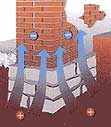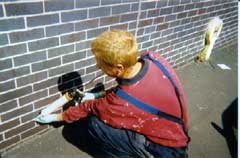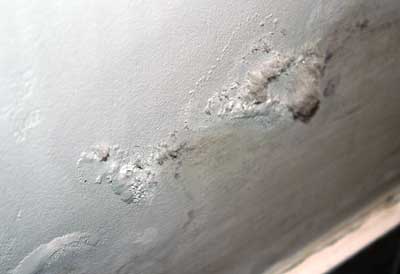Chemical Damp Proof Courses - Q's & A's
What is a chemical damp proof course used for
Chemical damp-proof courses are inserted to control the vertical passage of moisture from the ground upwards through building materials (brick, stone, concrete) and are almost all installed in properties where no damp-proof course exists, or it has broken down with age (not a common occurrence, contrary to popular opinion in the Damp Proofing Trade).
We specialize in finding out the real cause of your dampness and then giving you the facts. Only when you have those facts should you make any decisions about products. In many situations no specialist products are required - only general maintenance items available from B&Q and Homebase. If you do need anything special we may offer to supply it - but you have no obligation to purchase from us.
Most chemical damp proof courses are not required and have no useful effect. There are simple reasons for this, which are happy to discuss by letter, E Mail or telephone.
Before spending money on any damp proofing product go to our Diagnosis page and check the source of your damp for yourself - it is not 'rocket science' - click here
See our Article about types of Damp Proof Course - click here.
Visit our Surveying Shop to see simple aids to diagnosis - click here
For help with uses call our experts on 01626 872886 .


Before treatment, then after installing a DPC
Click to go to the top of the page
How is a modern chemical damp proof course installed
Chemical damp-proof courses should be installed in a position in accordance with good practice as described in BS 6576:1985, "Code of Practice for the Installation of Chemical Damp-proof Courses", a minimum of 150mm (6 inches) above external ground level, in external walls. If the installer does not follow the basic rules the damp proof course will be useless.
Additional rules apply to cavity walls, vertical damp proof courses and internal walls.
So called DPCs are installed in walls by various methods depending on the particular system being employed, but the ultimate objective is to provide a water repellent or pore blocking material in a continuous horizontal band in the masonry, to act as an effective 'barrier' to water rising from the ground.
These days Silicone Cream emulsion is used most commonly. It requires no special equipment to install, no pressure and has no chemical hazards.

Check the source of your damp for yourself - it is not difficult - click here
See our Article about installing different types of Damp Proof Course - click here.
See our Shop for damp proofing pumps and equipment - click here
For help with installation methods and rules call our experts on 01626 872886 .
Click to go to the top of the page
What is Rising Damp and what is the difference between Natural or Man Made rising damp
'True' rising damp is entirely natural ground water rising by capillary action through porous building materials. The natural water in the ground under a building climbs up through the porous parts of the walls and floors up to the point where surface evaporation stops further climb.
This natural rising damp is extremely rare in buildings that have any kind of damp proof course - slate, bitumen or plastic. It will not normally climb very high - say 6 to 9 inches (150 to 225mm) above the skirting board and even that process will take tens of years.
And yet this is the only type of rising damp recognised by most Damp Proofing Specialists.
Man-made Rising Damp arises from water leaks and 'bridging' of the damp proof course. It is usually much more damp to the touch because more water, nearer to the surface is available, so the damage is more sudden and severe. This is the most common cause of ground floor damp symptoms in buildings today and it is not cured by installing a new damp proof course of any kind. It can rise much higher (over a metre) and happen much quicker (within days or weeks of a leak).

Rising damp in Blue.
Before spending money on one go to our Diagnosis page and check the source of your damp for yourself - we don't mind explaining - click here
For help with the causes of damp call our experts on 01626 872886 .
Click to go to the top of the page
Why is 'Rising Damp' sometimes referred to as a 'Myth' by the Press
Because most dampness problems in buildings are NOT caused by natural rising dampness. They are entirely Man Made!
In most cases they are caused by building defects, such as:
- water leaks inside the building - particularly in modern buildings fitted with plastic damp proof course and membrane materials
- water leaks under the building or from next door or the road - particularly in older buildings, built prior to the use of plastics
- 'bridging' of the damp proof course - mainly by paths, roads, steps and added structures
Before spending money on one go to our Diagnosis page and check your damp for yourself - it is easy to read, non technical stuff - click here
For help with the MYTHS call our experts on 01626 872886 .
Click to go to the top of the page
What is the most common lie told about damp proof courses in building
That traditional damp proof courses (slate, stone, bitumen) break down!
Buried inside the wall structure they do not significantly break down, so do not need replacement.
There is no evidence that they fail in service and yet a whole industry has been created around this idea.
Before spending money on one go to our Diagnosis page and check your damp for yourself - there is nothing to lose - click here
For help with diagnosis call our experts on 01626 872886 .
Click to go to the top of the page
How does a chemical damp proof course work in theory
The only continuous pathways through which water can rise through a wall are the mortar beds: for water to pass, say, from brick to brick it must still cross a mortar bed (bottom of figure, right). It is therefore essential that the damp-proofing material impregnates the mortar courses since these form the major pathway for the rise of water within walls. Damp-proofing the masonry units (e.g., bricks) alone is of very little value!
Porous mortar and impervious/water repellent brickwork will still allow rising dampness to occur. However, if the pores in the mortar line are made water repellent or blocked then the water cannot rise since it cannot traverse the mortar beds to do so.
BUT, bear in mind that even if this new DPC was installed to perfection (unlikely) it will not deal with residual damp above the new DPC or the inevitable 'salt' contaminants, some of which suck moisture from the air.

Water repelled - in Blue.
(Note - the degree of repellancy shown is hugely optimistic because damp continues to rise up to the new DPC.)
Don't spend money yet - go to our Diagnosis page and check your damp for yourself - you have nothing to lose - click here
For help with how damp proof courses work call our experts on 01626 872886 .
Click to go to the top of the page
Installing a chemical DPC in new mortar or new build
In the majority of older properties the mortar is not alkaline, so that the water repellent formulations based either silicone resins, aluminium stearate, or methyl siliconate (sodium or potassium methyl siliconate) can be used. Occasionally, however, the mortar may highly alkaline such as in a recently constructed wall (e.g. where the physical damp-proof course has been omitted). This will exclude the use of the methyl siliconates since the highly alkaline conditions found, for example, in new mortars prevent the formation of the water repellent resin.
Before spending money check your damp for yourself - we'll help you for free - click here
For help with types of damp proofing fluids and creams and where to use them call our experts on 01626 872886 .
Click to go to the top of the page
Bridging existing damp proof courses
Care should be taken to ensure that the damp-proof course is not 'bridged' by high external ground levels, blocked cavities or debris piled against the wall; ground levels should be lowered, cavities cleaned out or the area below the inserted damp-proof course might be 'tanked' internally if deemed necessary.
NOTE: Should minor bridging of an effective damp-proof course occur, for example by moderately porous plasterwork, then it is highly unlikely that the dampness would continue to rise to its original height. If the damp-proof course is effective the pathway for moisture should be limited within the wall itself. Any porous plasterwork is at the surface where evaporation would serve to restrict the flow of rising water through it.
Therefore, moisture is unlikely to pass through this relatively narrow pathway at a rate sufficient for it to reach the height of rise prior to the insertion of the damp-proof course assuming, of course, that the injected damp-proof course is moderately effective. Problems of this type together with defects in construction of the floor/wall junction usually manifest themselves at the base of the wall.
Before spending money on one go to our Diagnosis page and check your damp for yourself - there is nothing to lose - click here
For help with 'bridging' and blocked cavities call our experts on 01626 872886 .
Click to go to the top of the page
Internal wall damp - not likely to be 'natural' rising damp
Walls that have no external outside face (said to be' internal' walls) are never likely to need damp proof injection - because they are never likely to suffer from natural rising damp.
Internal walls are most likely to suffer from water leaks under the floor - mains water, sewage (there is unlikely to be a smell due to the filtering effect of the soil), or central heating leaks. Check all these systems first see our Water Leak Testing section - click here
If the internal wall is a shared wall (Party Wall) go next door and ask to see the matching area - the source may not be under your house.
Your House Insurance may cover the cost of repair - check your Excess and call the Insurer to advise them of the probable leak. Take lots of dated photographs as evidence.
Don't waste money on internal walls - go to our Diagnosis page and check your damp for yourself - save your money - click here
For help with types of damp proofing fluids and creams and where to use them call our experts on 01626 872886 .
Click to go to the top of the page
Cavity wall damp - not likely to be 'natural' rising damp
Walls that have a cavity (usually in older houses about 1 inch - 25mm wide, but up to 4 inches - 100mm in modern houses) between the inner and outer bricks or blocks, however small that cavity is, are never likely to need damp proof injection - because they are never likely to suffer from natural rising damp. A clean cavity gives good air flow between the walls and even if outside ground levels are a little high ('bridging' due to rainwater splash up) the evaporation will ensure that dampness does not reach inside to spoil decorations.
Cavity walls are most likely to suffer from debris in the cavity or damp cavity insulation - see our Article about cavity walls - click here.
Your cavity may have been filled with polystyrene beads or Rockwool. Ask the Installer to check for debris in the cavity - such debris allows moisture to move from outside to inside, both above and below the damp proof course. Rockwool will become soggy if enough dampness is trapped.
Ask for details of our Cavity Cleaning Method.
For help with types of damp proofing fluids and creams and where to use them call our experts on 01626 872886 .
Click to go to the top of the page
Why not Render or Tank the walls to stop rising damp
Walls that have damp inside for whatever reason, above the damp proof course, need good evaporation on both sides to ensure that dampness does not climb the walls any further.
So called 'Tanking' a wall with a liquid sealer (paint or cement slurry) or applying a dense Render of sand and cement with 'waterproofer' will cut down or eliminate the essential evaporation that dries a wall out (they only dry very slowly - the Building Research Establishment (BRE) give an average of 0.5 to 1.0 inch (12.5mm to 25mm) of wall thickness per month, assuming that both sides of the wall can breathe)
Tanking and rendering result in the trapped moisture being driven higher over time - eventually the moisture will appear above the level of the Tanking or render and may show in the form of a 'salt band'.
The reason for the continued rise of moisture is simple - the so called 'rising damp' was not natural and the man made source has not been eliminated, so the new chemical damp proof course is ineffective.

Salts bursting through paint - Render or Tanking can drive this higher
Don't drive water up your wall behind a waterproof layer - go to our Diagnosis page and check your damp for yourself - save some money and time - click here
For help with types of damp proofing fluids and creams and where to use them call our experts on 01626 872886 .
Click to go to the top of the page
Why 'Wicking' defeats even modern, plastic damp proof courses
A 100% effective DPC in a modern house is made of plastic and unlike a chemical damp proof course should be a total barrier to water trying to move upwards in a wall by capillary action. But when water is present below the plastic layer, usually in modern buildings due to an internal water leak above the floor membrane, it simply bypasses the damp proof layer by being sucked up via the plaster and the back of the tightly fitted wooden skirting board.
The same 'wicking' problem occurs in older buildings where water dampens the soil or concrete under a suspended floor - the water vapour rises in the air, condenses on the walls and climbs the faces of the bricks or blocks, past the DPC layer and into the wall via the plaster. The skirting boards also play their part in 'wicking' and often rot as a consequence.
Some buildings have received four new damp proof courses before anyone has realised that water under the floor cannot be resisted by installing chemical or physical damp proof courses in the walls.
Under suspended timber floors the air bricks may cope with some of this excess moisture, but eventually the moisture rots the timbers.
In flats with ' Beam and Block' floors there is no floor membrane under the beams, so the vapour condenses on the underneath of the concrete beams and blocks, soaking in easily, giving rise to extremely cold floors and massive condensation and mold problems in the ground floor flats.
For help with types of damp proofing fluids and creams and where to use them call our experts on 01626 872886 .
Click to go to the top of the page
What age of building is most unlikely to need a chemical damp proof course
Traditional damp proof courses (slate, stone, bitumen) do not break down!
So any property that has one - say from about 1880 onwards - is unlikely to need injection.
Buried inside the wall structure they do not significantly break down, so do not need replacement.
There is no evidence that they fail in service and yet a whole industry has been created around this idea.
Buildings constructed after 1950 are even less likely to need injection and those built from the 1960s onwards had plastic DPCs, so should never need a chemical version.
Send us photos of your property for DPC identification - you probably need nothing - help@propertyrepairsystems.co.uk
For help with diagnosis call our experts on 01626 872886 .
Click to go to the top of the page
What is the proper answer to a damp problem
1. Analyse the problem - see our page - click here
2. Eliminate the faults - usually water leaks or high ground levels.
3. Remove the affected plaster and fit our Mesh Membrane - then replaster or plasterboard - see our Membrane Shop - click here
The Mesh Membrane is vented so that air can pass behind it - it is NOT a Tanking System - it does not seal the wall, so dampness is not driven higher.
For help with types of damp proofing fluids and creams and where to use them call our experts on 01626 872886 .
Click to go to the top of the page
Learn from the UK's top Expert: become your own expert - save money.
Quick DIY Master Class in Dampness and Condensation - become your own Expert in 1 hour! Buy our "Dampness in Buildings" reprinted book by the great expert Graham Coleman. A great read, short and to the point.
Click here to buy the reprint.
Click to go to the top of the page
Home | Damp | Plastering | Membrane | Damp Meters | Anti-Mould Additives
Privacy Policy | Returns Policy | Contact
Use any of our Shopping Pages to place goods in your Shopping Basket - they all use the same Shopping Cart system.

Click to view your Shopping Basket
or continue shopping by clicking on one of our Shops below.
OUR SHOPPING PAGES- DAMP SHOP - this Site, for Damp problem solving in buildings
- TANKING SHOP - this Site, for Damp problems below ground level
- MOLD SHOP - this Site, for Mold problems and their solutions
- SURVEYING TOOLS SHOP - this Site, for tools for surveying your building for damp
- DAMP PROOFING EQUIPMENT SHOP - pumps, injection rods, spray lances
- BORON TREATMENTS SHOP
- WOODWORM PRODUCTS SHOP
- DRY ROT SHOP
- BORACOL SHOP
- JOIST REPAIR KITS SHOP
- TIMBER REPAIR SHOP
- RESINS SHOP
- MEMBRANE FOR DAMP WALLS & FLOORS SHOP
- FIRE PAINTS SHOP
- RUST CONTROL SHOP
Property Repair Systems
T: 01626 872886
E: Mail us help@propertyrepairsystems.co.uk
Site written by: David Moore
David Moore, B.A. (Hons.), C.T.I.S., C.R.D.S. Technical Author
Google+
Other Property Repair Systems Sites:
www.boron.org.uk - how to use Boron based insecticides/fungicides to treat timber rots and insect attack
www.deck-treatment.co.uk - how to treat patio decks and yacht decks
www.dryrot.biz - how to kill Dry Rot in buildings
www.drywallandfloor.co.uk - membranes for lining damp walls, floors, basements and cellars
www.epoxy-info.co.uk - resins for repairing and sealing all types of masonry
www.fire-door-paint.co.uk - upgrade doors to 30 minutes fire resistance
www.joist-repair.co.uk - how to quickly repair joists and beams of any size
www.propertyrepairsystems.co.uk - our Home Site
www.steel-fire-paint.co.uk - treat steel with Intumescent Paint to provide fire protection
www.timber.org.uk - systems of repair, with step by step methods
www.timber-repair.co.uk - how to repair timber beams
www.woodworm-info.co.uk - how to kill and prevent woodworm and death watch beetle
www.woodworm-expert-advice-forum.org.uk - all your questions and our answers about woodworm treatment DIY
